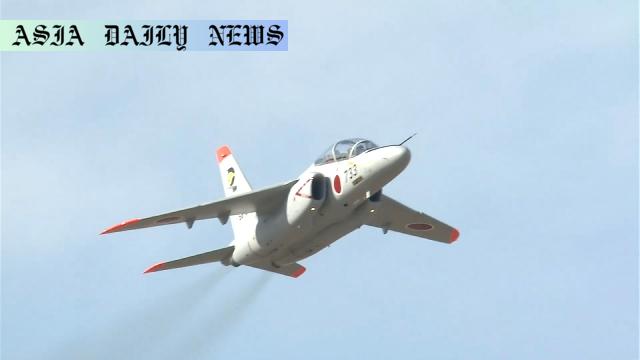ASDF Aircraft Crash: Japan’s T-4 jet crashes in central Japan reservoir; two crew members missing in Inuyama City.
A T-4 trainer jet of the Japan Air Self-Defense Force crashes into a reservoir.
Two crew members remain missing as search and recovery efforts continue.
Defense Ministry investigates the cause of the crash, with oil detected on the reservoir’s surface.

Japan’s ASDF Aircraft Incident in Aichi Prefecture
The recent crash of a Japan Air Self-Defense Force (ASDF) T-4 intermediate trainer aircraft into a reservoir in central Japan has sent shockwaves across the nation. The accident, which occurred on Wednesday afternoon, involved two crew members who remain missing as of last reports. This tragic event has brought attention to aviation safety concerns and the complexities of military training operations.
The aircraft, originating from the Komaki Air Base, Aichi Prefecture, embarked on its journey at 3:06 PM. However, within just two minutes after takeoff, the T-4 disappeared from radar, marking the beginning of a grim sequence of events. It ultimately crashed into the Irukaike reservoir in Inuyama City, leaving behind visible wreckage and an oil slick on the water’s surface. The search operations, undertaken by the Self-Defense Force with assistance from local police, remain ongoing as authorities work tirelessly to locate the missing personnel.
No injuries among nearby residents have been reported, providing a small measure of relief amidst the grim circumstances. The discovery of oil floating on the reservoir’s north side is a stark reminder of the environmental impact, adding an additional layer of complexity to recovery efforts. Early investigations indicate that the aircraft was part of a mission assigned to Nyutabaru Air Base, located in Miyazaki Prefecture, southwestern Japan, where it was scheduled to transport personnel and execute operational tasks.
Broader Implications of the Incident
Accidents of this nature serve as sobering reminders of the risks associated with military aviation. The T-4 aircraft is frequently utilized for training purposes and intermediate missions, making its role critical in preparing pilots for larger and more complex aircraft within the ASDF fleet. It also underscores the demanding nature of aviation training, where real-world conditions must be simulated with precision and safety precautions at every step.
The crash site, located over 10 kilometers northeast of Komaki Air Base and 5 kilometers southeast of Inuyama Station, raises questions about the risks posed by military operations near civilian areas. Events like these ignite discussions around safety protocols and operational planning, pushing authorities to reassess procedures to ensure public safety while balancing military readiness.
Investigations into the crash will likely include a review of mechanical systems, weather conditions, human factors, and the details of the mission itself. The establishment of a thorough inquiry process is crucial to identifying the root cause and preventing similar tragedies in the future. Transparency in findings will also reassure the public of the defense forces’ commitment to accountability and safety improvement.
Conclusion and Path Forward
The ASDF is bearing the weight of this tragedy as it undertakes rescue and recovery efforts. While the focus now remains on locating the two missing crew members, the incident serves as a broader lesson for military operations and safety. The loss of two personnel, if confirmed, would be deeply felt not just within the organization but also across Japan, where respect for service members remains high.
Moving forward, this incident will likely inform policy changes, training methodologies, and aircraft maintenance routines. Aviation authorities and the Defense Ministry must collaborate closely to implement the lessons learned and demonstrate a commitment to enhancing safety measures. Public reassurance will be key as Japan continues to rely on its Self-Defense Force to safeguard national and regional security interests.



Commentary
Reflections on a Tragic Incident
For any nation, the loss of its defense personnel is not only a tragedy but also a moment of reckoning. The recent ASDF T-4 aircraft crash in central Japan is a reminder of the inherent risks associated with serving in roles that safeguard the nation. The disappearance of the two crew members has left a void that can only be partially filled by understanding and addressing what went wrong.
This incident highlights the challenges faced by defense aviation. Intermediate training aircraft, such as the T-4, play a crucial role in bridging the gap between basic pilot training and advanced operations. However, their critical importance often masks the dangers associated with their use. In this case, questions about mechanical reliability, environmental conditions, and procedural safeguards loom large, making it essential to conduct a thorough investigation.
Another facet that warrants discussion is the impact on civilians. While the ASDF’s rigorous planning likely minimizes risks to civilian populations, accidents near populated areas must serve as reminders to prioritize public safety. The lack of injuries in this case is fortunate, but such incidents prompt a reevaluation of operational strategies and flight corridors to ensure safety for all.
Lessons for the Future
As Japan comes to terms with this tragedy, it must also look ahead. The lessons from this incident can shape policies to balance national security with operational safety. Keeping the public informed with transparency and empathetic communications will be critical in maintaining trust in the ASDF and its mission. Additionally, advancements in technology, such as better monitoring systems and enhanced training protocols, must play a more prominent role in reducing risks across the board.
As the search continues for the missing crew, our thoughts go out to their families and colleagues. Their service and dedication to Japan’s security underscore the value of those who dedicate their lives to their country, often under considerable personal risk.